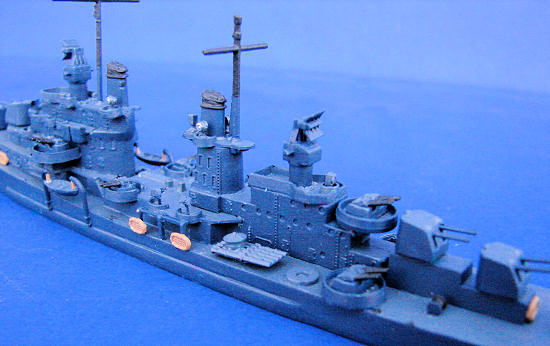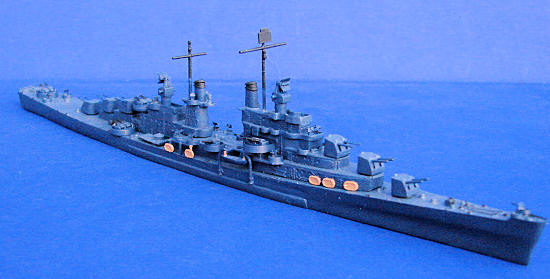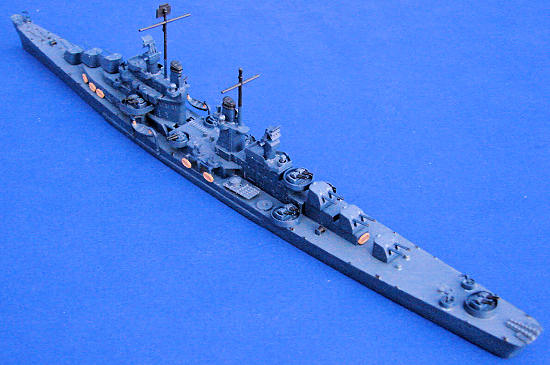
Revell AG 1/700 CL-95 USS Oakland
| KIT #: | ? |
| PRICE: | ? |
| DECALS: | None supplied |
| REVIEWER: | Mark Hiott |
| NOTES: | Modified USS San Juan kit |

| HISTORY |
The Atlanta
Class cruisers were United States Navy light cruisers designed originally as
flotilla leaders but which ended up gaining recognition as effective
anti-aircraft cruisers during World War II. The first ship of the class, USS
Atlanta, was launched
6 September 1941. She had a
length of 541ft and dis placed
6,000 tons.
With eight
dual 5 in (127 mm)/38 cal gun mounts (six centerline), the first run of
Atlanta-class cruisers had by far the heaviest anti-aircraft broadside of any
warship of World War II, at over 17,600 lb (10,560 kg) per minute of
highly-accurate, radar-fuzed VT ordnance.
placed
6,000 tons.
With eight
dual 5 in (127 mm)/38 cal gun mounts (six centerline), the first run of
Atlanta-class cruisers had by far the heaviest anti-aircraft broadside of any
warship of World War II, at over 17,600 lb (10,560 kg) per minute of
highly-accurate, radar-fuzed VT ordnance.
Criticisms of
the class included that of a shortage of gunfire directors for the main battery,
which reduced its effectiveness. There was also an insufficient number of
intermediate AA guns (i.e., Bofors 40 mm). These problems were rectified by late
1942, but the ships were also overloaded, and throughout their lives they had
issues with topside weight. Further, ship's armor was relatively thin, having a
maximum of 3.5 in (88.9 mm) at the side, with the bridge and mounts being
protected by a mere 1.25 in (31.75 mm).
The USS Oakland, was a modified Atlanta-class light cruiser, the group of ships sometimes referred to as the "Oakland-class". This class differed from the standard Atlanta class in that the two aft wing 5in turrets were deletaed and additional AA guns were fitted. She was laid down by Bethlehem Steel Co., on 15 July 1941; launched on 23 October 1942; and commissioned on 17 July 1943. On 1 July 1949, USS Oakland decommissioned at San Francisco. Struck on 1 March 1959, she was sold on 1 December 1959 for scrapping.
| THE KIT |
 The box contains 4 sprues molded in a light gray plastic, 2 for the ship
itself and 2 weapons sprues. There are more weapons on the sprues then you will
use, so the spare parts bin will get a healthy addition. The 1-piece upper hull
is molded with a separate lower section so it can be built as a waterline or
full hull. The lower aft section of the hull is also separate, but there is only
one choice for assembly so I suppose there are other boxings available. (with or
without the torpedo bulge?)
The box contains 4 sprues molded in a light gray plastic, 2 for the ship
itself and 2 weapons sprues. There are more weapons on the sprues then you will
use, so the spare parts bin will get a healthy addition. The 1-piece upper hull
is molded with a separate lower section so it can be built as a waterline or
full hull. The lower aft section of the hull is also separate, but there is only
one choice for assembly so I suppose there are other boxings available. (with or
without the torpedo bulge?)
Detail is good and there is very little flash and the ejector marks are on the
backs of bulkheads etc. Even the gun tubs have the ejector marks in the center.
Instructions are the usual RoG issue. Four double sided pages with a marking layout on the last page.
| CONSTRUCTION |
I
got this kit in a multi-kit trade and it had been partly assembled. The hull and
superstructure had been assembled and it was painted in Measure 33. In looking
through the kit I also discovered that one of the main gun barrels was missing.
Since the  Juan
Juan
Luckily, the Revell kit includes all the parts needed to build any of the
Atlanta/Oakland class ships. Research is needed to determine which parts will be
needed to do each ship as the instructions donít make any mention of the extra
parts. Using photos off the net I chose to model the
 The
first thing to do was to remove the superstructure that had already been
assembled and strip the Measure 33 paint job. The superstructure was easily
popped off and a soaking in Easy Off took care
The
first thing to do was to remove the superstructure that had already been
assembled and strip the Measure 33 paint job. The superstructure was easily
popped off and a soaking in Easy Off took care of the paint. Choosing the parts I needed, I built the ship in sections: main
hull, bridge structure and aft structure. On the hull I added the extra gun tubs
called for. Once all the sections were built and painted, they were added to the
already completed hull.
of the paint. Choosing the parts I needed, I built the ship in sections: main
hull, bridge structure and aft structure. On the hull I added the extra gun tubs
called for. Once all the sections were built and painted, they were added to the
already completed hull.
While most of the details were nicely done, I decided the supplied 20mm guns
were just too big. Not wanting to sink a lot of money into this build, I used a
GMM 20mm fret I bought for a different project. The GMM set includes 60 20mm
guns and separate gun shields. It was more then enough for both projects. I
needed 12 20mm guns for the
| COLORS & MARKINGS |
 The
The
No
decals were installed.
| CONCLUSIONS |
The
Revell kit, while simple, builds up into a very nice model. In fact, it looks so
nice, that I may end up adding p/e railings at a later date.
While I canít say for sure, I THINK this kit is identical to the Dragon 1/700
CL-53 USS San Diego kit. The sprues sure look the same.
| REFERENCES |
Wikipedia for the history
LOTS
of photos off the Internet
Various book from my reference shelf
January 2012
If you would like your product reviewed fairly and fairly quickly, please contact the editor or see other details in the Note to Contributors.